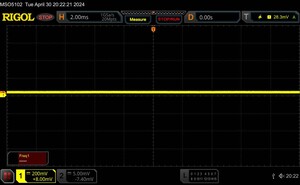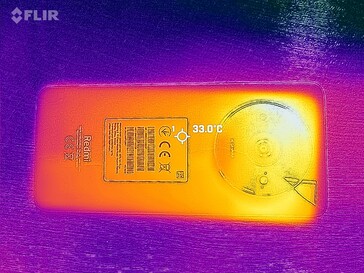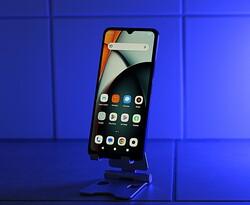小米红米 A3 智能手机评测--经济型手机的诸多升级
潜在的竞争对手比较
Rating | Version | Date | Model | Weight | Drive | Size | Resolution | Price from |
|---|---|---|---|---|---|---|---|---|
| 64 % | v8 | 06 / 2024 | Xiaomi Redmi A3 Helio G36, PowerVR GE8320 | 193 g | 64 GB eMMC Flash | 6.71" | 1650x720 | |
| 73.8 % v7 (old) | v7 (old) | 07 / 2023 | Xiaomi Redmi A2 Helio G36, PowerVR GE8320 | 192 g | 32 GB eMMC Flash | 6.52" | 1600x720 | |
| 77.7 % v7 (old) | v7 (old) | 05 / 2024 | Motorola Moto G04 T7200 (T606), Mali-G57 MP1 | 179 g | 64 GB UFS 2.2 Flash | 6.56" | 1612x720 | |
| 70.2 % v7 (old) | v7 (old) | 02 / 2023 | Blackview A52 SC9863A, GE8322 / IMG8322 | 183.6 g | 32 GB eMMC Flash | 6.50" | 1600x720 |
» Notebookcheck多媒体笔记本电脑Top 10排名
» Notebookcheck游戏笔记本电脑Top 10排名
» Notebookcheck低价办公/商务笔记本电脑Top 10排名
» Notebookcheck高端办公/商务笔记本电脑Top 10排名
» Notebookcheck工作站笔记本电脑Top 10排名
» Notebookcheck亚笔记本电脑Top 10排名
» Notebookcheck超级本产品Top 10排名
» Notebookcheck变形本产品Top 10排名
» Notebookcheck平板电脑Top 10排名
» Notebookcheck智能手机Top 10排名
» Notebookcheck评测过最出色的笔记本电脑屏幕
» Notebookcheck售价500欧元以下笔记本电脑Top 10排名
» Notebookcheck售价300欧元以下笔记本电脑Top 10排名
请注意:我们已经更新了评级系统,第 8 版的结果与第 7 版的结果不具可比性。
外壳和连接 - 全新外观
小米红米 A3 是继 红米 A2的后续机型。当时,我们批评了其迟缓的 Wi-Fi 连接和 micro-USB 端口,现在我们已经可以说,小米至少在其后续机型中改进了这两点。
不过,让我们先从手机外壳说起:红米 A3 与它的前身肯定不会有混淆的风险--小米已经完全重新设计了这款智能手机。这款手机也明显更长、更宽,但高度有所降低。因此,红米 A3 的屏幕面积更大,而重量几乎没有变化。不过,屏幕周围的边框仍然较宽,但在这个价位范围内是可以接受的。
背面经过重新设计,采用了大面积的圆形摄像头模块,与俏皮的前代产品相比,外观更加精致。它的颜色选择也更加成熟,包括墨绿色、黑色或中蓝色。闪亮的外壳很容易留下指纹印。小米红米 A3 的两侧可以轻微扭动,在显示屏上施加中等压力,屏幕上的液晶就会变得清晰可见。手机做工完美无瑕。
小米官方给出的售价是 130 美元(3GB 内存和 64GB 存储空间),而 4GB 内存和 128GB 存储空间的大存储配置则需要 150 美元左右。这使得这款手机的价格比前代产品更高,不过,你已经可以在网上以略低的价格买到这款手机。
与前代产品相比,红米 A3 的一大优势是配备了 USB-C 接口,这使得手机与充电器和线缆的兼容性更强。小米的这款现代经济型手机不支持 NFC。
它继续采用专用 microSD 卡插槽,因此您可以在插入两张 SIM 卡的同时插入一张存储卡。在我们使用 Angelbird V60 作为 microSD 卡参考的测试中,读卡器的速度在同价位手机中算是不错的,但在任何时候都无法充分发挥快速 microSD 卡的潜力。
| SD Card Reader - average JPG Copy Test (av. of 3 runs) | |
| Average of class Smartphone (7.7 - 77, n=73, last 2 years) | |
| Xiaomi Redmi A3 (Angelbird V60) | |
| Motorola Moto G04 | |
| Xiaomi Redmi A2 (Angelbird V60) | |
| Blackview A52 (Angelbird V60) | |
Cross Platform Disk Test (CPDT)
通信、软件和操作 - 最后 90 赫兹和指纹传感器
在无线局域网方面,小米红米 A3 还进行了进一步的升级:它终于拥有了支持 WiFi 5 全速的模块,而且小米红米 A3 能够相对较好地使用这些模块--这就是我们使用华硕 ROG Rapture AXE11000 参考路由器进行测试的结果。它现在能够达到 300 MBit/s 左右的速度,而且波动也没有那么大。这意味着你也可以很好地使用更快的网络集合。
红米 A3 是一款 4G 手机,只支持最必要的频率。这意味着你可以在中欧旅行时仍然使用这款手机连接网络,但在更远的地方旅行时,它支持的频率范围可能就不够用了。
小米给价格实惠的红米 A3Android 14 作为软件基础,并没有做太多改动。最新的安全补丁是从 2024 年 3 月开始的,因此可以进行更新。尽管如此,制造商还是承诺了两个主要的Android 更新和三年的安全补丁,这对于如此廉价的智能手机来说并不总是必然的。这也确保了这款手机在我们的可持续发展评级中获得加分。
小米红米 A3 的屏幕频率为 90 赫兹,因此系统看起来总体上更加流畅。即便如此,在这款经济实惠的手机上,你还是不得不忍受偶尔出现的卡顿或掉帧现象。
集成在待机键上的指纹传感器也是一个新功能。保存指纹后,稍作停顿即可解锁手机,非常可靠。您还可以使用前置摄像头通过 2D 面部识别解锁设备。
| Networking | |
| Xiaomi Redmi A3 | |
| iperf3 transmit AXE11000 | |
| iperf3 receive AXE11000 | |
| Xiaomi Redmi A2 | |
| iperf3 transmit AXE11000 | |
| iperf3 receive AXE11000 | |
| Motorola Moto G04 | |
| iperf3 transmit AXE11000 | |
| iperf3 receive AXE11000 | |
| Blackview A52 | |
| iperf3 transmit AXE11000 | |
| iperf3 receive AXE11000 | |
照相机 - 可拍摄快照
它的摄像头没有太大变化:小米安装了与红米 A2 相同的传感器。 红米 A2.这意味着它的背面只有一个 800 万像素的摄像头,并配有一个深度传感器用于人像拍摄。
主摄像头很好地完成了 HDR 照片的拍摄,照片中的植物背景很亮,主体本身几乎没有光线照射。两个平面的曝光都很好,但你已经可以注意到花瓣上的一些细节缺失。在我们周围环境的照片中,浅色区域丢失了许多单个细节,总体而言缺乏锐度。尽管如此,作为一张快照还是不错的。
在烛光下,你几乎可以看清拍摄对象,但照片却相当模糊。当我们在摄影棚内以仅 1 lux 的照度照亮测试图时,手机摄像头不再提供任何可用的照片。另一方面,在照相馆的全部照明下,照片看起来相对清晰,只有红色背景导致文字看起来有点模糊。
录制的视频最高分辨率为 1080p,每秒 30fps;整体看起来相当模糊,自动对焦速度也很慢。
500 万像素前置摄像头拍摄的照片乍一看还不错,但一旦放大就会失去很多细节。
Image Comparison
Choose a scene and navigate within the first image. One click changes the position on touchscreens. One click on the zoomed-in image opens the original in a new window. The first image shows the scaled photograph of the test device.
Main camera plantMain camera surroundingsMain camera low light

显示屏 - 不同寻常的宽高比
与前代机型相比,红米 A3 的屏幕纵横比有所不同:红米 A3 现在的屏幕更长,宽度也差不多,因此新的屏幕纵横比更接近 21:9。这很不寻常,但却能实现相当纤薄的设计。
红米 A3 的分辨率扩大到了 720p,在同类产品中达到了预期水平,但亮度不足 400 cd/m²,还有待改进。夏天在户外使用手机时,这可能会成为一个问题。此外,红米 A3 没有真正的亮度传感器,而是通过使用前置摄像头的虚拟传感器来测量环境光线。这并不那么准确,我们在测试中也注意到了这一点:时不时地,屏幕会对非常明亮或昏暗的环境做出不正确的反应。
除此之外,该屏幕没有 PWM 功能,而且偏蓝现象严重;几乎所有颜色,尤其是黄色,都显示得不准确。
| |||||||||||||||||||||||||
Brightness Distribution: 92 %
Center on Battery: 368 cd/m²
Contrast: 1314:1 (Black: 0.28 cd/m²)
ΔE Color 3.76 | 0.5-29.43 Ø4.87
ΔE Greyscale 4.5 | 0.5-98 Ø5.1
95.1% sRGB (Calman 2D)
Gamma: 2.277
| Xiaomi Redmi A3 IPS, 1650x720, 6.7" | Xiaomi Redmi A2 IPS, 1600x720, 6.5" | Motorola Moto G04 IPS, 1612x720, 6.6" | Blackview A52 IPS, 1600x720, 6.5" | |
|---|---|---|---|---|
| Response Times | 20% | -1% | 5% | |
| Response Time Grey 50% / Grey 80% * | 54.3 ? | 36.8 ? 32% | 47.8 ? 12% | 45.2 ? 17% |
| Response Time Black / White * | 25.2 ? | 23.2 ? 8% | 28.5 ? -13% | 27 ? -7% |
| PWM Frequency | ||||
| Screen | 4% | 3% | -15% | |
| Brightness middle | 368 | 391 6% | 414 13% | 432 17% |
| Brightness | 359 | 379 6% | 396 10% | 400 11% |
| Brightness Distribution | 92 | 94 2% | 91 -1% | 88 -4% |
| Black Level * | 0.28 | 0.3 -7% | 0.34 -21% | 0.26 7% |
| Contrast | 1314 | 1303 -1% | 1218 -7% | 1662 26% |
| Colorchecker dE 2000 * | 3.76 | 3.31 12% | 3.26 13% | 6.97 -85% |
| Colorchecker dE 2000 max. * | 7.19 | 7.67 -7% | 6.74 6% | 10.36 -44% |
| Greyscale dE 2000 * | 4.5 | 3.6 20% | 3.9 13% | 6.7 -49% |
| Gamma | 2.277 97% | 2.307 95% | 2.075 106% | 2.618 84% |
| CCT | 7305 89% | 7427 88% | 6914 94% | 7976 81% |
| Total Average (Program / Settings) | 12% /
7% | 1% /
3% | -5% /
-11% |
* ... smaller is better
Display Response Times
| ↔ Response Time Black to White | ||
|---|---|---|
| 25.2 ms ... rise ↗ and fall ↘ combined | ↗ 10.8 ms rise | |
| ↘ 14.4 ms fall | ||
| The screen shows relatively slow response rates in our tests and may be too slow for gamers. In comparison, all tested devices range from 0.1 (minimum) to 240 (maximum) ms. » 58 % of all devices are better. This means that the measured response time is worse than the average of all tested devices (20.8 ms). | ||
| ↔ Response Time 50% Grey to 80% Grey | ||
| 54.3 ms ... rise ↗ and fall ↘ combined | ↗ 29 ms rise | |
| ↘ 25.3 ms fall | ||
| The screen shows slow response rates in our tests and will be unsatisfactory for gamers. In comparison, all tested devices range from 0.165 (minimum) to 636 (maximum) ms. » 90 % of all devices are better. This means that the measured response time is worse than the average of all tested devices (32.5 ms). | ||
Screen Flickering / PWM (Pulse-Width Modulation)
| Screen flickering / PWM not detected | |||
In comparison: 53 % of all tested devices do not use PWM to dim the display. If PWM was detected, an average of 8516 (minimum: 5 - maximum: 343500) Hz was measured. | |||
性能、排放和电池寿命 - 小功率
联发科 联发科 Helio G36这绝不是一款功能强大的手机,即使对于如此廉价的手机来说,它也只能提供微弱的动力。这意味着你在浏览设备菜单时就会遇到卡顿,而要求苛刻的应用程序很快就会把智能手机逼到极限。例如,全高清流媒体播放就是一个问题:在没有复制保护的情况下,它的性能往往不足以流畅播放全高清流媒体--例如 YouTube 上的流媒体。此外,这款智能手机没有通过 Widevine L1 认证,这意味着它甚至无法在许多主要平台上选择高清流媒体。
3 GB 的低内存也是一个问题,导致复杂的应用程序甚至无法启动。数据存储区内的虚拟内存速度较慢也是一个问题。该手机的速度足以完成简单的任务,如编写 WhatsApp 消息或上网。大容量存储器的速度也相当慢,因此在复制过程中可能会出现一些延迟。
在长时间负载后,我们测得机壳的最高温度为 39.5 °C,这并不是一个问题,在温度较高的环境中仍有一定的缓冲空间。遗憾的是,3DMark 压力测试无法在手机上运行,因此我们使用了较早的 GFXBench T-Rex 压力测试。我们注意到几乎没有任何波动,运行 30 次后,设备的性能与开始时相差无几。
与 红米 A2A3的扬声器位于顶部边缘。这很不寻常,但不一定是个坏主意。另一方面,它的音质并不是最好的,因为它的高音很重,导致音乐听起来不是很有趣。最好通过 3.5 毫米插孔或蓝牙连接耳机或扬声器。这样听起来要好得多,最重要的编解码器都可用于无线传输,甚至包括用于高保真音频的 LDAC 和 aptX HD。
手机完全充满电需要三个小时,最大功率为 10 瓦。虽然没有随附充电器,但这款智能手机可以与大多数现成的充电器配合使用。它的电池容量仍为 5,000 毫安时,续航时间与前代产品差不多--我们在 Wi-Fi 测试中测得的续航时间为 15:02 小时。因此,与同价位手机相比,小米红米 A3 的续航时间也不错。
| PCMark for Android - Work 3.0 | |
| Average of class Smartphone (4507 - 27169, n=196, last 2 years) | |
| Motorola Moto G04 | |
| Xiaomi Redmi A2 | |
| Average Mediatek Helio G36 (4609 - 4761, n=2) | |
| Xiaomi Redmi A3 | |
| 3DMark | |
| 2560x1440 Sling Shot Extreme (ES 3.1) Unlimited | |
| Average of class Smartphone (508 - 23762, n=157, last 2 years) | |
| Motorola Moto G04 | |
| Xiaomi Redmi A3 | |
| Average Mediatek Helio G36 (n=1) | |
| 2560x1440 Sling Shot Extreme (ES 3.1) Unlimited Graphics | |
| Average of class Smartphone (453 - 40163, n=157, last 2 years) | |
| Motorola Moto G04 | |
| Xiaomi Redmi A3 | |
| Average Mediatek Helio G36 (n=1) | |
| 2560x1440 Sling Shot Extreme (ES 3.1) Unlimited Physics | |
| Average of class Smartphone (877 - 10632, n=157, last 2 years) | |
| Motorola Moto G04 | |
| Xiaomi Redmi A3 | |
| Average Mediatek Helio G36 (n=1) | |
| Octane V2 - Total Score | |
| Average of class Smartphone (2228 - 100368, n=210, last 2 years) | |
| Xiaomi Redmi A2 | |
| Average Mediatek Helio G36 (4398 - 5207, n=2) | |
| Blackview A52 | |
| Xiaomi Redmi A3 | |
| Motorola Moto G04 | |
| Xiaomi Redmi A3 | Xiaomi Redmi A2 | Motorola Moto G04 | Blackview A52 | Average 64 GB eMMC Flash | Average of class Smartphone | |
|---|---|---|---|---|---|---|
| AndroBench 3-5 | -5% | 266% | -17% | 6% | 742% | |
| Sequential Read 256KB | 270.1 | 268.9 0% | 978.7 262% | 226.4 -16% | 274 ? 1% | 2030 ? 652% |
| Sequential Write 256KB | 118.2 | 116.1 -2% | 389.3 229% | 119.4 1% | 177.3 ? 50% | 1646 ? 1293% |
| Random Read 4KB | 65.5 | 53.6 -18% | 184.1 181% | 40.5 -38% | 59.9 ? -9% | 282 ? 331% |
| Random Write 4KB | 41 | 40.5 -1% | 201.2 391% | 35 -15% | 32.7 ? -20% | 325 ? 693% |
温度
(+) The maximum temperature on the upper side is 39.5 °C / 103 F, compared to the average of 35.1 °C / 95 F, ranging from 21.9 to 63.7 °C for the class Smartphone.
(+) The bottom heats up to a maximum of 38.8 °C / 102 F, compared to the average of 33.9 °C / 93 F
(+) In idle usage, the average temperature for the upper side is 23.2 °C / 74 F, compared to the device average of 32.8 °C / 91 F.
发言人
Xiaomi Redmi A3 audio analysis
(±) | speaker loudness is average but good (78.8 dB)
Bass 100 - 315 Hz
(-) | nearly no bass - on average 36.2% lower than median
(±) | linearity of bass is average (9.8% delta to prev. frequency)
Mids 400 - 2000 Hz
(±) | higher mids - on average 5.9% higher than median
(±) | linearity of mids is average (7.7% delta to prev. frequency)
Highs 2 - 16 kHz
(+) | balanced highs - only 4.1% away from median
(±) | linearity of highs is average (7.5% delta to prev. frequency)
Overall 100 - 16.000 Hz
(±) | linearity of overall sound is average (28.3% difference to median)
Compared to same class
» 72% of all tested devices in this class were better, 5% similar, 23% worse
» The best had a delta of 12%, average was 36%, worst was 134%
Compared to all devices tested
» 84% of all tested devices were better, 3% similar, 13% worse
» The best had a delta of 4%, average was 24%, worst was 134%
Blackview A52 audio analysis
(±) | speaker loudness is average but good (81.6 dB)
Bass 100 - 315 Hz
(-) | nearly no bass - on average 37.1% lower than median
(+) | bass is linear (6.6% delta to prev. frequency)
Mids 400 - 2000 Hz
(±) | higher mids - on average 6.6% higher than median
(±) | linearity of mids is average (13.3% delta to prev. frequency)
Highs 2 - 16 kHz
(±) | higher highs - on average 7% higher than median
(±) | linearity of highs is average (10.3% delta to prev. frequency)
Overall 100 - 16.000 Hz
(-) | overall sound is not linear (31.2% difference to median)
Compared to same class
» 79% of all tested devices in this class were better, 3% similar, 18% worse
» The best had a delta of 12%, average was 36%, worst was 134%
Compared to all devices tested
» 89% of all tested devices were better, 2% similar, 9% worse
» The best had a delta of 4%, average was 24%, worst was 134%
运行时间
| Battery Runtime - WiFi Websurfing | |
| Average of class Smartphone (476 - 3244, n=206, last 2 years) | |
| Motorola Moto G04 | |
| Xiaomi Redmi A3 | |
| Xiaomi Redmi A2 | |
| Blackview A52 | |
Pros
Cons
评语:改进多多的小米红米 A3
说到红米 A3,小米确实在努力为预算不多的用户提供最好的手机:新设计看起来更精致,有一个 USB-C 接口(虽然欧盟的规定可能在这方面起到了帮助作用),Wi-Fi 速度更快,90 Hz 屏幕,指纹传感器,以及相对不变的Android 14 软件和三年更新保证。
这意味着,与上一代产品相比,该产品有了很大改进,我们的一些批评意见也得到了解决。不过,我们也必须注意到,这款手机的速度仍然很慢,即使在同价位手机中也是如此。虽然小米已经升级了内存,但对于入门级手机来说,3GB RAM 还是太少了。
它的屏幕还可以更亮一些--尤其是在阳光明媚的日子里,而且缺少 NFC 功能也在一定程度上限制了它的使用。
三年更新承诺和快速 Wi-Fi 等特殊功能使红米 A3 成为经济型智能手机中一个有趣的选择。不过,迟缓的 SoC 会拖慢手机的运行速度。
如果您在 红米 A2和红米 A3 之间纠结,那么我们肯定会建议你选择更现代的红米 A3。性能更好的替代品可能是 摩托罗拉 Moto G04它的运行速度也更流畅。
请注意:我们最近更新了评级系统,第 8 版的结果与第 7 版的结果不具可比性。
价格和供应情况
目前,通过亚马逊购买新款小米红米 A3 的最便宜价格为 98.99 美元。
Xiaomi Redmi A3
- 07/02/2024 v8
Florian Schmitt
Transparency
The selection of devices to be reviewed is made by our editorial team. The test sample was provided to the author as a loan by the manufacturer or retailer for the purpose of this review. The lender had no influence on this review, nor did the manufacturer receive a copy of this review before publication. There was no obligation to publish this review. We never accept compensation or payment in return for our reviews. As an independent media company, Notebookcheck is not subjected to the authority of manufacturers, retailers or publishers.
This is how Notebookcheck is testing
Every year, Notebookcheck independently reviews hundreds of laptops and smartphones using standardized procedures to ensure that all results are comparable. We have continuously developed our test methods for around 20 years and set industry standards in the process. In our test labs, high-quality measuring equipment is utilized by experienced technicians and editors. These tests involve a multi-stage validation process. Our complex rating system is based on hundreds of well-founded measurements and benchmarks, which maintains objectivity. Further information on our test methods can be found here.





























 Total Sustainability Score:
Total Sustainability Score: 








